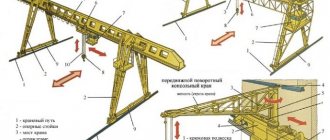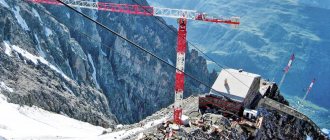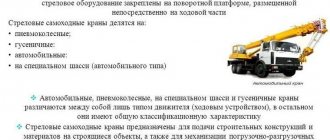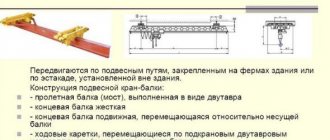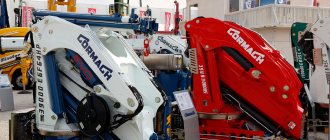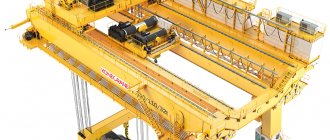A jib crane is a device that has been around for a long time. Some historians call the date of its appearance the Middle Ages, others attribute the invention of the device to the hands of blacksmiths. That is, it appeared many centuries ago and continues to be improved in our time. Some components and mechanisms of the device are made using higher quality and reliable materials. Electrical units and motors are widely used.
Design Features
The design of the cantilever rotary crane includes an I-beam console as a base. It is mounted on a special column, which is firmly attached to the foundation using specialized brackets. The working body is a beam and a boom with an installed gripping hook.
Main equipment components:
Jib crane
- console;
- Column;
- support bracket;
- rolling support;
- traction chain, clamp;
- stops, covers;
- bearings, dampers.
The devices are manufactured strictly in accordance with regulatory documentation, therefore they have fixed technical parameters. The design of column-mounted jib cranes is regulated by GOST-19811-74, which contains detailed drawings and requirements.
Loads are moved vertically. The operating radius of the equipment depends on technical parameters: angle of rotation, boom radius.
Links
- Electronic version of TSB // Great Soviet Encyclopedia: [in 30 volumes] / ch. ed. A. M. Prokhorov. — 3rd ed. - M.: Soviet Encyclopedia, 1969-1978.
| Cable | Cable • Bridge cable |
| Cantilevered | Bicycle • Wall-mounted • Column, free-standing • Double-post • With a fixed console • With a rotating console |
| Mostovoy | Gantries • Hydraulic • Metallurgical • Reloaders • Semi-gantry • Polar and reactor |
Types of lifting consoles
Devices of this type are classified according to their mobility. The jib crane can be:
Types of jib cranes
- stationary – fixed at the workplace and does not move;
- mobile – such a device can move within predetermined limits.
The design of electric jib-slewing cranes can be equipped with manual rotation of the console. This solution allows you to use the equipment in places where there are no sources of electricity.
The wall-mounted design of the device is characterized by high reliability and performance characteristics. The mechanism is installed on the wall to move goods nearby.
Mechanical devices are controlled using a remote control. Both manual and mechanical variations are equipped with electric hoists or manual hoists. The latter option is used for relatively light materials. Hoists are designed to work with heavy objects.
Wall mounted jib crane
Excerpt characterizing the Jib Crane
He stopped and rubbed his face and eyes with his hands. “Well, here,” he continued, apparently making an effort on himself to speak coherently. “I don’t know since when I love her.” But I have loved only her, only one, all my life and love her so much that I cannot imagine life without her. Now I don’t dare ask her hand; but the thought that maybe she could be mine and that I would miss this opportunity... opportunity... is terrible. Tell me, can I have hope? Tell me what should I do? “Dear princess,” he said, after being silent for a while and touching her hand, since she did not answer. “I’m thinking about what you told me,” answered Princess Marya. - I'll tell you what. You’re right, what should I tell her about love now... - The princess stopped. She wanted to say: it is now impossible to talk to her about love; but she stopped because for the third day she saw from Natasha’s sudden change that not only would Natasha not be offended if Pierre expressed his love to her, but that this was all she wanted. “It’s impossible to tell her now,” Princess Marya said. - But what should I do? “Entrust this to me,” said Princess Marya. “I know...” Pierre looked into Princess Marya’s eyes. “Well, well...” he said. “I know that she loves... will love you,” Princess Marya corrected herself. Before she had time to say these words, Pierre jumped up and, with a frightened face, grabbed Princess Marya by the hand. - Why do you think so? Do you think I can hope? You think?! “Yes, I think so,” said Princess Marya, smiling. - Write to your parents. And instruct me. I'll tell her when it's possible. I wish this. And my heart feels that this will happen. - No, this cannot be! How happy I am! But this cannot be... How happy I am! No, it can not be! - Pierre said, kissing the hands of Princess Marya. – You go to St. Petersburg; it is better. “And I’ll write to you,” she said. - To St. Petersburg? Drive? Okay, yes, let's go. But can I come to you tomorrow? The next day Pierre came to say goodbye. Natasha was less animated than in previous days; but on this day, sometimes looking into her eyes, Pierre felt that he was disappearing, that neither he nor she was any more, but there was only a feeling of happiness. “Really? No, it can’t be,” he said to himself with every look, gesture, and word that filled his soul with joy. When, saying goodbye to her, he took her thin, thin hand, he involuntarily held it in his a little longer. “Is this hand, this face, these eyes, all this alien treasure of feminine charm, will it all be forever mine, familiar, the same as I am for myself? No, this is impossible!..” “Goodbye, Count,” she told him loudly. “I’ll be waiting for you,” she added in a whisper. And these simple words, the look and facial expression that accompanied them, for two months formed the subject of Pierre’s inexhaustible memories, explanations and happy dreams. “I will be waiting for you very much... Yes, yes, as she said? Yes, I will be waiting for you very much. Oh, how happy I am! What is this, how happy I am!” - Pierre said to himself. Nothing now happened in Pierre's soul similar to what happened in it in similar circumstances during his matchmaking with Helen. He did not repeat, as then, with painful shame the words he had spoken, he did not say to himself: “Oh, why didn’t I say this, and why, why did I say “je vous aime” then?” [I love you] Now, on the contrary, he repeated every word of hers, his own, in his imagination with all the details of her face, smile, and did not want to subtract or add anything: he only wanted to repeat. There was no longer even a shadow of doubt as to whether what he had undertaken was good or bad. Only one terrible doubt sometimes crossed his mind. Isn't this all in a dream? Was Princess Marya mistaken? Am I too proud and arrogant? I believe; and suddenly, as should happen, Princess Marya will tell her, and she will smile and answer: “How strange! He was probably mistaken. Doesn’t he know that he is a man, just a man, and I?.. I am completely different, higher.” Only this doubt often occurred to Pierre. He also didn’t make any plans now. The impending happiness seemed so incredible to him that as soon as it happened, nothing could happen. It was all over. A joyful, unexpected madness, of which Pierre considered himself incapable, took possession of him. The whole meaning of life, not for him alone, but for the whole world, seemed to him to lie only in his love and in the possibility of her love for him. Sometimes all the people seemed to him to be occupied with only one thing - his future happiness. It sometimes seemed to him that they were all as happy as he was, and were only trying to hide this joy, pretending to be busy with other interests. In every word and movement he saw hints of his happiness. He often surprised people who met him with his significant, happy looks and smiles that expressed secret agreement. But when he realized that people might not know about his happiness, he felt sorry for them with all his heart and felt a desire to somehow explain to them that everything they were doing was complete nonsense and trifles, not worth attention. When he was offered to serve or when they discussed some general, state affairs and war, assuming that the happiness of all people depended on this or that outcome of such and such an event, he listened with a meek, sympathetic smile and surprised the people who spoke to him with his strange remarks. But both those people who seemed to Pierre to understand the real meaning of life, that is, his feeling, and those unfortunate ones who obviously did not understand this - all people during this period of time seemed to him in such a bright light of the feeling shining in him that without the slightest effort, he immediately, meeting any person, saw in him everything that was good and worthy of love.
Variation of cargo altitude characteristics
The lifting capacity of column-mounted jib cranes varies from 0.5 to 16 tons. Range of other characteristics:
- boom radius, m – from 2.5 to 6 or 10;
- lifting height, m – from 2 to 4 or 5.
If the angle of rotation of the equipment is 240 degrees, the first numbers are relevant - the maximum boom reach is 6 m and the lifting height is 4 m.
Lifting characteristics of jib crane
Main characteristics
Main technical parameters of lifting equipment:
Jib crane - dimensions
- classification according to GOST 25546 - 2K, according to ISO 4301/1 - A2;
- execution – U, HL, UHL;
- placement according to standard 15150 – 1, 2, 3, 4;
- device rotation drive and control – manual;
- hoist control – manual, electric remote control;
- control position – from the floor;
- electrical wire – cable connection;
- load mass during testing – 1.25 for static testing, 1.1 for dynamic testing.
The last paragraph indicates a portion of the rated load capacity indicated in the passport.
Column-mounted, stationary manual KKR jib cranes, lifting from 0.25 to 5 tons (type 3 - free-standing on a column)- column-mounted jib crane is designed for lifting, lowering and horizontal movement of cargo. The crane console rotates around the axis of the column fixed to the foundation. The rotation of the crane is carried out by manual traction using the handle of the traction chain. Lifting, lowering and moving the load along the crane console is carried out using a manual or electric hoist.
- The area of application
of the KKR crane is warehouses, industrial premises and general open areas. - Column-mounted manual console cranes KKR with a lifting capacity from 0.25 to 5 tons are produced by SVPC in accordance with TU 3159-019-12573741-2014, GOST 19494 “Stationary rotary manual console cranes”, Federal norms and rules in the field of industrial safety “Safety rules for hazardous production facilities where lifting structures are used.”
- Cantilever cranes on a column with manual rotation are available with a lifting height of 2; 2.5; 3.2; and 4 meters with a maximum reach of up to 5 meters (see table with crane dimensions below).
- Stationary manual cantilever rotary cranes are designated as follows: KKR Х–ХХ–ХХХ–ХХХХ–ХХХХХ TU 3159-019-12573741-2014
, where KKR is the symbol of the crane; X - type of jib crane (3 - free-standing on a column); XX - designation of the crane's lifting capacity in tons; XXX - maximum hook reach in meters (for example 3.2); XXXX - lifting height in meters (for example 2.5); XXXXX - designation of climatic version according to GOST 15150 (for example U3). - An example of a symbol for a stationary jib crane with manual rotation of the console, type 3, with a lifting capacity of 2.0 tons, with the largest hook reach L2 max=3.2 m and a lifting height of 2.5 meters; version U, for placement category 3: KKR 3-2.0-3.2-2.5-U3 TU 3159-019-12573741-2014
- column-mounted jib crane consists of the following main components and parts: console (1), column (2), support bracket (3), rolling support (4), latch (5), traction chain (8), stop 4 pcs. (9), cover (10), bearing (30), ring (31), damper 6 pcs. (34). Other items indicated in the diagram are fasteners (screws, bolts, nuts, washers).
- Manual console cranes produced by SVPK of all lifting capacities (from 0.25 to 5 tons) are also manufactured in explosion-proof and/or fireproof versions.
- jib rotary valves comply with the requirements of GOST 31441.1-2011 and GOST 31441.5-2011, have explosion protection marking II Gb with T3 X. Ensure safe use in hazardous areas of classes 1 and 2 according to GOST IEC 60079-10-1-2011 (GOST R IEC 60079-10-1-2008) premises and outdoor installations in which the formation of explosive mixtures of categories IIA, IIB and IIC and temperature groups T1, T2, T3 according to GOST R IEC 60079-20-1-2011 is possible.
- Manual console cranes in a fireproof design must ensure safe operation in fire hazardous areas of classes P-I; P-II; P-IIa; P-III according to PUE-7 and have appropriate additional markings.
- An example of the designation of an explosion-proof stationary console crane with manual rotation of the console, type 3, with a lifting capacity of 2.0 tons, with the largest hook reach L2 max = 3.2 m and a lifting height of 2.5 meters, version U, for placement category 3: KKR-Ex-3-2.0- 3.2-2.5-U3 TU 3159-019-12573741-2014
. - By agreement with the customer, it is possible to manufacture cranes in an earthquake-resistant design on the MSK-64 scale up to 9 points inclusive.
- Manual column-mounted console cranes produced by SVPC are reliably and high-quality painted, which protects them from corrosion for many years (also in conditions of year-round outdoor use).
- Installation, start-up, and regulation of the crane must be carried out in accordance with the requirements set out in the attached passport and the operating manual for the stationary manual rotary console crane.
- The KKR manual rotary jib crane is not intended for transporting people, molten and hot metal, toxic substances, for working in an explosive environment, for operation in a room with vapors of acids and alkalis, the concentrations of which cause corrosion of the crane structure.
- column-mounted jib crane is shipped mothballed and disassembled. Large faucet parts are supplied without packaging. Components and parts are packed in boxes/boxes and labeled. The documentation is enclosed in a plastic bag.
- To ensure the normal, trouble-free functioning of the components and parts of the crane, the owner must provide an appropriate maintenance system during operation - in accordance with the passport and manual.
- The manufacturer guarantees the crane's compliance with the requirements of the technical specifications and relevant regulatory documents (FNP and GOST) subject to the consumer's compliance with the operating, transportation and storage conditions set out in the Passport and OM.
- The warranty period is 24 months from the date of commissioning of the crane, but not more than 36 months from the date of shipment from the manufacturer. The service life when operating in passport mode is 20 years. The service life before the first major overhaul is 10 years.
Console stationary rotary manual cranes can be used indoors, under a canopy and outdoors. By agreement, climate control valves U, UHL, KHL can be manufactured; accommodation category 1, 2, 3, 4.
Console
It is a prefabricated welded structure and consists of
a load-bearing beam, a support bracket
and a rolling support, which is attached to the bottom of the support bracket. During installation, the supporting beam, support bracket and rolling support are connected by means of bolted joints and then welded. The axis serves to connect the console to the column and is the axis of rotation of the console.
Column
consists of a pipe welded on one side to the base, which is attached to the foundation. The ribs provide rigidity to the structure. On the other side, a crown is welded into which a cage for installing the bearing is welded and is the connection point with the console. The rolling rings located on the column pipe provide support for the rollers when the crane rotates. At the top of the column there are brackets for limiting the rotation of the console and a service hatch.
The console assembly is installed with its axle in the column race bearing. Before testing and commissioning, the console is aligned to the horizon using adjusting bolts and secured with tightening bolts.
The traction chain is attached to the end plate of the console
.
A manual
or
electric hoist is installed on the supporting beam of the console , which is used to lift and move the load.
If an electric hoist is installed on the console, a string is also provided for hanging the cable. Manual jib slewing cranes KKR (type 3 - on a column): main dimensions, weight
| h, mm | h1, mm | h2, mm | L1, mm | L2, mm | D2, mm | Weight, t | ||
| 0,25 | 2910 | 460 | 2000 | 1500 | 550 | 2500 | 700 | 0,67 |
| 0,25 | 2910 | 460 | 2500 | 1500 | 550 | 2500 | 700 | 0,7 |
| 0,25 | 2910 | 460 | 3200 | 1500 | 550 | 2500 | 700 | 0,76 |
| 0,25 | 2910 | 460 | 4000 | 1500 | 550 | 2500 | 700 | 0,8 |
| 0,25 | 3610 | 460 | 2000 | 1500 | 550 | 3200 | 700 | 0,68 |
| 0,25 | 3610 | 460 | 2500 | 1500 | 550 | 3200 | 700 | 0,76 |
| 0,25 | 3610 | 460 | 3200 | 1500 | 550 | 3200 | 700 | 0,76 |
| 0,25 | 3610 | 460 | 4000 | 1500 | 550 | 3200 | 700 | 0,8 |
| 0,25 | 4410 | 460 | 2000 | 1500 | 550 | 4000 | 700 | 0,72 |
| 0,25 | 4410 | 460 | 2500 | 1500 | 550 | 4000 | 700 | 0,75 |
| 0,25 | 4410 | 460 | 3200 | 1500 | 550 | 4000 | 700 | 0,8 |
| 0,25 | 4410 | 460 | 4000 | 1500 | 550 | 4000 | 700 | 0,85 |
| 0,5 | 3400 | 460 | 2000 | 1500 | 450 | 3200 | 900 | 1,0 |
| 0,5* | …* | …* | …* | …* | …* | …* | …* | …* |
| 1,0 | 3200 | 460 | 2000 | 1500 | 450 | 3200 | 900 | 1,4 |
| 1,0* | …* | …* | …* | …* | …* | …* | …* | …* |
| 2,0 | 3425 | 700 | 2000 | 1500 | 550 | 3200 | 1100 | 2,2 |
| 2,0* | …* | …* | …* | …* | …* | …* | …* | …* |
| 3,2 | 3425 | 700 | 2000 | 1500 | 550 | 3200 | 1300 | 5,05 |
| 3,2* | …* | …* | …* | …* | …* | …* | …* | …* |
| 5,0 | 3480 | 700 | 2500 | 1500 | 1045 | 3200 | 1400 | 3,9 |
| 5,0* | …* | …* | …* | …* | …* | …* | …* | …* |
* Dimensions and characteristics for manual column-mounted KKR cranes with a lifting capacity of 0.25 - 0.5 - 1 - 2 - 3.2 - 5 tons can be downloaded VIA THIS LINK, file in PDF format. A fragment of the technical specifications is downloaded.
The values indicated in the table and diagram: L1 - smallest offset; L2 - maximum reach; h1 - lifting height; h - vertical approach; L is the length of the console from the axis of rotation. The crane weight is indicated without hoist.
Manual column-mounted jib cranes: main characteristics
| Characteristic | Meaning |
| Crane classification (mode) group according to GOST 25546 (ISO 4301/1) | 2K (A2) |
| Group of classification (mode) of mechanisms according to GOST 25835 (ISO 4301/1) Main lift (hoist) - Crane rotation - Trolley movement - | see data sheet for hoist 2M see data sheet for hoist |
| Climatic design (options according to agreed requirements) | U, UHL, HL |
| Category of accommodation according to GOST 15150 (to be agreed) | 1, 2, 3, 4 |
| Type of console rotation drive | Manual |
| Console rotation control method | Manual |
| Method of controlling a manual hoist - electric hoist - | Manual Electric from remote control |
| Control place during operation | From the floor |
| Method of current supply to an electric hoist (if available) | Cable |
| Mass of test loads for static tests - for dynamic tests - | 1.25 nominal g/p 1.1 nominal g/p |
Manual jib rotary cranes: explosion-proof and fireproof versions. Earthquake resistant design.
Additional Information.
Please pay attention!
The above sketches and photographs do not accurately define the design of each faucet and are for reference only. Specific parameters of the crane must be agreed upon with sales managers. Each crane is designed separately based on the agreed customer requirements. The crane manufacturer reserves the right to make changes and improvements to the standard crane design without changing the information on the website. >>Return to previous page “Console cranes”





